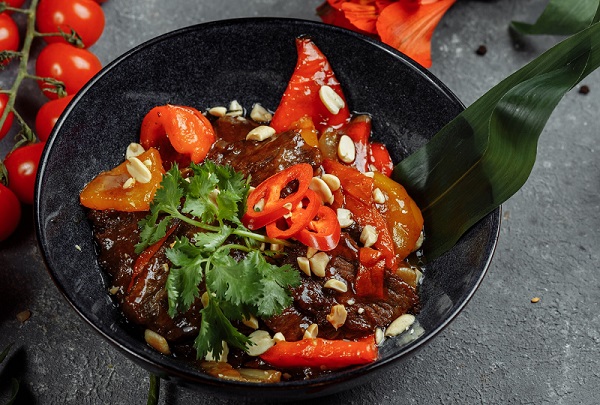Get ready for a sizzling showdown between two Asian-inspired beef dishes: Mongolian Beef vs Pepper Steak! Both dishes boast tender, juicy slices of beef coated in savory sauces, but each has its own unique flavor profile and cooking method. So, which one will reign supreme?
Join us as we dive into the delicious details of these two dishes and discover what makes them both so irresistible.
Mongolian Beef Vs Pepper Steak: What’s The Difference?
If you’re a fan of Chinese-American cuisine, then you’re probably familiar with Mongolian beef and pepper steak. These two dishes are often found on Chinese takeout menus and are both made with sliced beef, soy sauce, and brown sugar. However, they have some key differences that set them apart from each other.
Pepper steak has a more savory, umami taste, while Mongolian beef is more mildly sweet. Both recipes use some of the same ingredients, such as soy sauce and brown sugar, but pepper steak replaces the sweeter hoisin sauce found in Mongolian beef with more savory oyster sauce. Additionally, pepper steak features sliced bell peppers, bamboo shoots, and other seasonings such as ginger, while Mongolian beef is often paired with scallions or mixed vegetables and is not typically spicy.

What is Mongolian Beef?
Mongolian Beef is a flavorful and delicious meal that hails from Taiwan. This dish is typically made with thinly sliced flank steak, which is cooked to perfection with onions and a savory sauce that infuses the beef with delicious flavors. While the dish is often not spicy, it packs a punch with its sweet and savory flavor profile.
One of the defining characteristics of Mongolian Beef is its versatile nature, as it can be paired with scallions or mixed vegetables, depending on your preference. This allows you to customize the dish to your liking and add some extra nutrients to the meal.
When it comes to serving Mongolian Beef, it’s commonly paired with steamed white rice, which perfectly complements the bold flavors of the dish. In the United States, crispy fried cellophane noodles are a popular choice for serving Mongolian Beef, as they add a satisfying crunch and texture to the meal.
What Is Pepper Steak?
Have you ever had the pleasure of savoring Pepper Steak at your local Chinese restaurant? If not, this recipe will give you the chance to indulge in this delicious stir-fry dish.
Pepper Steak is a delectable fusion of thinly sliced marinated steak (typically flank or sirloin) and crisp green and red bell peppers, all stir-fried to juicy perfection in a savory sauce. The sauce is usually soy-based, with a tantalizing blend of ginger, garlic, and cornstarch to thicken it up just right.
Believe it or not, this popular dish actually originated from a Hokkien cuisine favorite in the late 1940s. Hokkien cuisine, hailing from the provincial capital of Fuzhou, China, is known for its emphasis on umami taste and its light but flavorful dishes. The original version of Pepper Steak used pork instead of steak and was lightly seasoned compared to its modern Chinese American iteration.
This dish packs a punch of dynamic flavors that will make your mouth water. You’ll experience the salty goodness of soy sauce, combined with the sweet and salty flavors of oyster sauce. The garlic, ginger, and sesame oil add layers of complexity to the dish, while the brown sugar brings a touch of sweetness.
The sweet bell peppers perfectly balance out the savory sauce, creating a symphony of flavors in your mouth. And for those who like to add some heat to their dishes, feel free to spice it up with plenty of chili sauce. This Chinese Pepper Steak is sure to be a hit at your next dinner party or family gathering!
Mongolian Beef Recipe
we’re going to show you how to make a delicious Mongolian Beef & Peppers recipe that will have your taste buds dancing with joy. But first, let’s talk about the key ingredient that makes this dish so incredible – beef!
To start, we’re going to prep our veggies by chopping up some fresh garlic, ginger, and three different types of bell peppers to give this dish a beautiful array of colors. But it’s the beef that really steals the show here, and we recommend using flank steak for its tender, juicy texture.
Now, we’re going to stir-fry the beef to give it a crispy finish that will elevate the flavor to new heights. To do this, slice your flank steak into 1/4 inch pieces and coat them in cornstarch. This will help create a brown sear that will give the beef a rich, savory taste.
Next, we’ll make the star of the show – the sauce! This combination of brown sugar, soy sauce, honey, and other delicious ingredients will give your dish a deep, sweet, and savory flavor that you won’t be able to resist.
Now it’s time to cook the beef. The trick to getting it crispy without overcooking it is to do it in two batches. You don’t want to overcrowd your pan or you’ll lose that perfect brown finish. Use a cast iron skillet and heat it to medium heat, then add a high smoke point oil like vegetable or avocado oil. Avoid using olive oil. Sear the beef quickly and turn it, but don’t worry if it’s not fully cooked as it will continue to cook in the sauce.
Once the beef is browned, remove it from the pan and set it aside. In the same pan, stir-fry your veggies for about 3 to 4 minutes or until they’re just crisp and tender. Then, add the beef back to the pan and pour the sauce mixture over it. Let it simmer for about 3 to 4 minutes until the sauce thickens and becomes bubbly.
Finally, top your Mongolian Beef & Peppers with some sesame seeds for added crunch and enjoy! We hope this recipe has inspired you to get creative in the kitchen and try new things. Happy cooking!
Pro-Tips
When making your delicious beef dish, be sure to follow these pro-tips for optimal flavor and texture. First, create a crispy crust that locks in moisture by deep frying the beef on high heat. This initial step is crucial for a mouth-watering, crispy finish.
Next, when slicing your beef, be sure to cut against the grain. This will result in more tender meat that is easier to chew.
It’s also important to not overcrowd your skillet. Even with a large 12” skillet, cooking the beef in two batches is necessary. Overcrowding the skillet lowers the cooking temperature, resulting in overcooked and dried-out beef. Plus, it steams the beef and doesn’t allow for that delicious, crispy crust to form. Keep it spaced out for ultimate flavor and texture.
Pepper Steak Recipe
Let’s make some delicious Chinese Pepper Steak! First things first, we need to thinly slice our beef. To make it easier, pop it in the freezer for about an hour so it’s firm enough to slice but not fully frozen. To ensure maximum tenderness, it is recommended to slice the meat against the grain into ¼-inch-thick pieces. This technique helps to break down the muscle fibers and makes the beef more tender.
Now, let’s get that beef marinating! A good marinade is key to tenderizing cheaper cuts like flank steak. We’ll use a thick marinade made with soy sauce, sesame oil, rice wine, chili sauce, and cornstarch. Let it sit at room temperature for 30 to 60 minutes or refrigerate for up to 8 hours. Don’t forget to let it come to room temperature before cooking.
While the beef is marinating, let’s whisk together our stir fry sauce consisting of oyster sauce, soy sauce, chicken broth, brown sugar, Asian chili sauce, rice wine, Chinese 5 Spice, and cornstarch. You can make this ahead of time and refrigerate or wait until you’re ready to cook the beef.
When you’re ready to start cooking, heat up some peanut or vegetable oil in a large skillet over high heat until it’s smoking hot. We want to sear the beef to get that nice caramelization, so make sure not to overcrowd the pan. Cook in 2 to 3 batches, transferring the beef to a plate once it’s seared on both sides.
In the same pan, add more oil and sauté some onions, bell peppers, garlic, and ginger until they’re just softened. Add the beef back in and pour in the stir fry sauce. Cook everything together until the sauce has thickened and the vegetables are crisp-tender, about 1 to 2 minutes. Adjust the spice level with more chili sauce to your liking.
Now, enjoy this dynamic and savory Pepper Steak with a balance of sweet and salty flavors that’s sure to impress!
Pro-Tips
Let me share with you some pro-tips to take your Pepper Steak from tender to crispy:
If you prefer your steak crispy instead of tender, consider frying it instead of sautéing it. Simply toss the sliced beef in an additional 2 tablespoons of cornstarch just before cooking.
For frying, use a heavy bottom pan and fill it with vegetable oil or any other oil with a high smoking point until it reaches about 1/4-inch up the sides.
Heat the oil over medium-high heat until it’s very hot and smoking. You can check if the oil is ready by flicking a little water on it – it should sizzle.
Use tongs to add the beef to the pan in a single layer. Fry for 1 to 2 minutes or until the beef is deeply golden. If the beef is not completely submerged, flip it after 1 minute and cook for an additional minute on the other side or until it’s deeply golden.
Once the beef is fried, remove it from the pan and let it drain on a cooling rack set over paper towels. This will help to remove any excess oil and keep the beef crispy.
In Chinese Cuisine, What Type Of Beef Is Commonly Used?
Chinese restaurants commonly use flank steak in their stir-fry dishes, and it’s no surprise that it’s also a highly recommended beef cut for making stir-fry recipes. This cut of meat is both lean and tender, which makes it ideal for stir-frying as it quickly cooks and absorbs flavors easily.
What’s Another Name For Mongolian Beef?
In addition to being called Mongolian beef, this dish can also be referred to as Mongolian barbecue. However, it is important to note that Mongolian beef is not actually from Mongolia nor does it have any relation to Mongolian culture.
What’s The Difference Between Mongolian Beef And Kung Pao Beef?
When it comes to Chinese food, Kung Pao beef is a popular dish that often gets compared to Mongolian beef. Unlike Mongolian beef, Kung Pao beef originates from the Szechuan province and is known for its spicy flavor. The dish is made with a combination of dried red chili peppers and spicy hot sauce, which give it its signature heat.
While both dishes feature beef as the main protein, Kung Pao beef typically includes peanuts and vegetables such as bell peppers, celery, and onions, which provide a delicious crunch and depth of flavor. The contrast in textures and flavors makes for a mouthwatering dish that is sure to satisfy spicy food lovers.
On the other hand, Mongolian beef is not spicy at all and is often made with flank steak and onions. It is commonly paired with scallions or mixed vegetables and is usually served over steamed rice. The beef is sautéed rather than fried, resulting in a tender and flavorful dish that is perfect for those who prefer milder flavors.
While both dishes are delicious in their own right, they offer distinct differences in terms of spiciness and flavor profile, making them great options for a variety of taste preferences.
Why Is It Called Pepper Steak?
As mentioned earlier, Pepper Steak is called that because it contains peppers and steak. Contrary to what some may think, the name “pepper” in pepper steak does not actually refer to chili or black pepper. Instead, it alludes to the mild and sweet flavor of bell peppers. The dish is believed to have originated in the United States in the mid-20th century and has been a popular Chinese-American dish ever since.
Is Pepper Steak Healthy?
Pepper steak can be a healthy option when prepared properly. It is high in protein and can be a good source of Vitamin B12, which is important for the blood and immune system. Additionally, it can be cooked in low-fat oils to avoid an increased risk of diabetes or other dietary.
Frequently Asked Questions About Mongolian Beef Vs Pepper Steak
What does Mongolian beef taste like?
Get ready to experience the perfect balance of sweet and savory flavors with a slight kick of spice. The dish is loaded with aromatic ingredients such as ginger, garlic, green onions, and dried red chilis that give it a deep and fragrant taste.
What’s another name for pepper steak?
You might have heard of steak au poivre – a French dish that consists of a steak, typically filet mignon, coated with coarsely cracked peppercorns. This is the same as pepper steak.
What makes Mongolian beef different?
Mongolian beef is a delicious dish from Taiwan that uses sliced tender beef, often flank steak, and onions as its main ingredients. The dish is paired with scallions or mixed veggies and has a mildly sweet taste. You can enjoy it over steamed rice or crispy fried cellophane noodles.
What is the main difference between Mongolian beef and Beijing beef?
Although both dishes use thinly sliced beef, there are some differences. Mongolian beef typically uses green onions and a sweeter sauce made with hoisin sauce, while Beijing beef uses bell peppers and has a balance of sweet and savory flavors with the addition of vinegar and ketchup.
Is Mongolian beef greasy?
Not at all! Mongolian beef is a healthy dish that’s full of flavor. The thin slices of beef with minced garlic and ginger together with veggies of your choice make it delicious. Thin slices ensure that the steak is both tender and full of flavor.
What is the most tender steak for pepper steak?
To ensure that your pepper steak is restaurant-quality, it’s important to choose the right cut of meat. For a firm, tender, and sweeter flavor, pick fresh flank steak, sirloin, or round steak over frozen.
Does Mongolian Beef taste sweet?
Yes, Mongolian beef tastes sweet! Mongolian Beef is a popular recipe that’s loved by both adults and kids alike for a number of reasons. The sweet flavor of the dark brown sugar mixed with the salty soy sauce and the strong ginger and garlic creates an incredibly addicting taste.
Is Szechuan beef the same as Mongolian beef?
No, they are not the same. Mongolian beef has a milder taste and isn’t spicy at all. It uses hoisin sauce instead of oyster sauce, but both use soy sauce and brown sugar. On the other hand, Szechuan beef is much spicier and doesn’t have a sweet or nutty taste.
Which is hotter Kung Pao or Szechuan?
If you love a mild spice, then Kung Pao chicken is the dish for you. It has a sweet and nutty taste that’s complemented with a slight kick of spice. Meanwhile, Szechuan chicken is much spicier and doesn’t have the sweet or nutty taste that Kung Pao chicken does. Although both dishes are similar, they have their own unique flavors.


